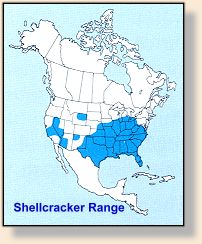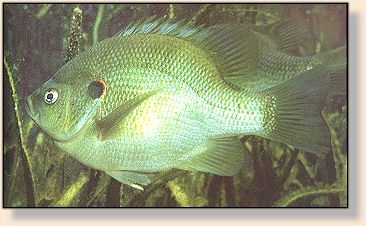 I'm sure that most of you know what shellcrackers are. These cousins
of bluegill get quite a bit larger than the average bluegill, and
are well known in the southern U.S.. They are somewhat speckled in
color, rather similar to the black crappie. They are shaped somewhat
like a crappie, too, being a bit more elongated than the typical
bluegill. The key identifying characteristic, though, is the bright
orange gill flap. It truly stands out. They are beautiful fish.
I think they are actually more picturesque than the bluegill, and
the only other fish I know that can compare is the sunfish.
I'm sure that most of you know what shellcrackers are. These cousins
of bluegill get quite a bit larger than the average bluegill, and
are well known in the southern U.S.. They are somewhat speckled in
color, rather similar to the black crappie. They are shaped somewhat
like a crappie, too, being a bit more elongated than the typical
bluegill. The key identifying characteristic, though, is the bright
orange gill flap. It truly stands out. They are beautiful fish.
I think they are actually more picturesque than the bluegill, and
the only other fish I know that can compare is the sunfish.
The shellcracker isn't often sought out in my area as the fish of
preference, and most catches are thought to be incidental. However, just
a bit of study will show that shellcracker catches can be a matter of
preference. For years, this area (northern Arkansas) was thought to be
the northern edge of shellcracker habitat, but the population of these
beautiful fish has increased dramatically over the past several years.
When I caught the first one I had ever seen, I had some problems
figuring out just exactly what it was. It was obviously a member
of the sunfish family, but what branch? I finally went to the local
library where I located a picture of a mature shellcracker, and
determined exactly what my catch was that day.
Many people will tell you that the shellcracker can only be caught
with live bait, and will not take flies . . .horse biscuits!!!! The
shellcracker is an opportunistic feeder, as are most predators, and
will take anything that resembles food. My best patterns are probably
any of several varieties of freshwater shrimp, but don't be afraid to
try poppers in the size range of #8-10. Actually, my favorite popper
for both bluegill and shellcrackers is commercial. It is tied by Tony
Accardo's company, and is called the Round Dinny. It's a cork ball
painted chartreuse, with white rubber legs and a black and green tail
of some sort of yarn. It could be easily duplicated, but it hardly
seems worth the effort when the commercial versions sell so cheaply.
As stated previously, freshwater shrimp are probably the best
patterns to use day in and day out, but several nymph patterns also
work well. The universal pheasant tail nymph is a winner, as are the
woolly bugger and the damsel-and dragonfly patterns.
Another local myth is that shellcrackers are found in deeper
waters than bluegill usually frequent. I haven't found this to be
true, either. I've caught shellcrackers in less than twelve inches of
water, and, more often than not, this is the depth where they actually
feed. I'm sure that many are caught in deeper water, but I feel that
they prefer shallow depths if sufficient cover is available.
Outside edges of shoreline weed beds are some of the top spots
for shellcrackers. Pay attention to both points and inlets in these
weed beds. These areas usually conform to the shape of the shoreline,
and are easy to locate. Drop your flies right against the weeds at
first, then move away until you contact fish. Any fish found in such
a place are usually actively feeding, and they can be caught on the
fly at these times.

The fish don't seem to be too picky about retrieves or realism
in patterns. Imitation or insinuation seems to be enough to draw a
strike. When you first hook a shellcracker, your first thought will
likely be, "Oh, God, it's a world record, what do I do now?" For one
thing, don't go with a 7x leader. These fish inhabit areas that offer
lots of heavy cover, and you're not likely to get one out with smaller
than 5x tippet. Most of the time, I don't measure tippet by X-sizes,
but by pound test. I usually prefer 6 or 8 pound test for most of
my shellcracker fishing, and sometimes move up to ten pound.
Overkill? Maybe, but I've had these stubborn fish tear off a
lip when trying to get into cover, and ten pound tippet certainly
isn't overkill with a big one. For the same reason, I seldom use
smaller than a size 10 or 12 hook. I get just as many hookups with
sizes 14 or 16, but seldom land the fish due to pull-offs. Keep in
mind, if they run five feet, they usually wrap around something.
It's like much warmwater fly fishing, hand-to-hand combat.
There is much speculation and scuttlebutt about shellcrackers,
and I certainly don't represent myself as an expert. These fish are
relative newcomers to my area, and I haven't had a huge amount of
experience with them. I do know, though, that I don't often find
them as deep as they are supposed to be. They seem to love the
outside of shoreline weed beds, and I often catch them in less
that twelve inches of water. They also hit poppers regularly,
which is something that they are not supposed to do. In short,
if you are ignoring shellcrackers, you are missing some good
days on the water. ~ Ron Griffith
|





